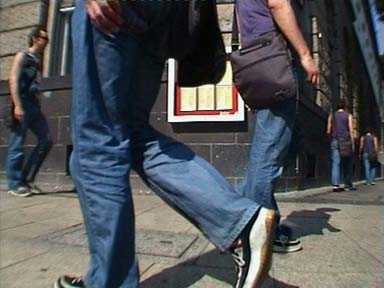|
single-channel
video installation
An overgrown garden: out of the distance comes a solitary person, then
another one and another one. People start walking in the other direction
and disappear into the distance. We see this coming and going of people
in a series of shots. The people are walking in and out of the garden
through a gate, over a courtyard and through the front door of a house
onto a busy street. Ultimately we see a street corner with many people
walking in all directions. It has, however, gradually become apparent
that all the people are the same - this place is entirely populated
by identical replicas. The sequence of cuts is reversed as an ever-diminishing
number of the replicas retreat back into the house, over the courtyard
and into the garden back to the source.
The confrontation with a world populated by replicas of one person creates
mixed feelings. Is this egoism on the part of the artist (for he has
populated this world with replicas of himself)? There is an innate drive
to reproduce and pass ones own genes on to the next generation. This
seems here to have been forced to the extreme of megalomania. A strange
variation on the solipsistic idea that the only being I know to be a
thinking, feeling consciousness is myself.
On the other hand what we see can also be viewed as a recognition of
the fact that, in many important ways, one person is the same as the
next, thus allowing empathy. Behind the superficial differences, we
all share certain drives, aims, hopes and fears, existing as thinking,
feeling beings in mutual dependency with the society as a whole.
Both views seem credible and the tension created by their apparent incompatibility
is exactly the interesting point. There is an increasing tendency towards
individualism in the western world. The emphasis is on self-fulfilment,
personal freedom, the uniqueness of a person’s own goals, perceptions
and needs. Other factors, whilst being forced into the background, cannot
be ignored: we are totally dependent on the society for the fulfilment
of even our most basic needs; as the procedures for the collection and
analysis of statistical information progress it becomes apparent that
our ‘individual’ behaviour is increasingly predictable.
As unpleasant as it might be, our self-perception as unique individuals
is threatened by a view where we are more like ants, one differing little
from the next, whose behaviour can be explained without the need for
the idea of free will.
THE SOURCE seeks to approach, in a visually simple way, a current existential
problem of deep complexity.
|

